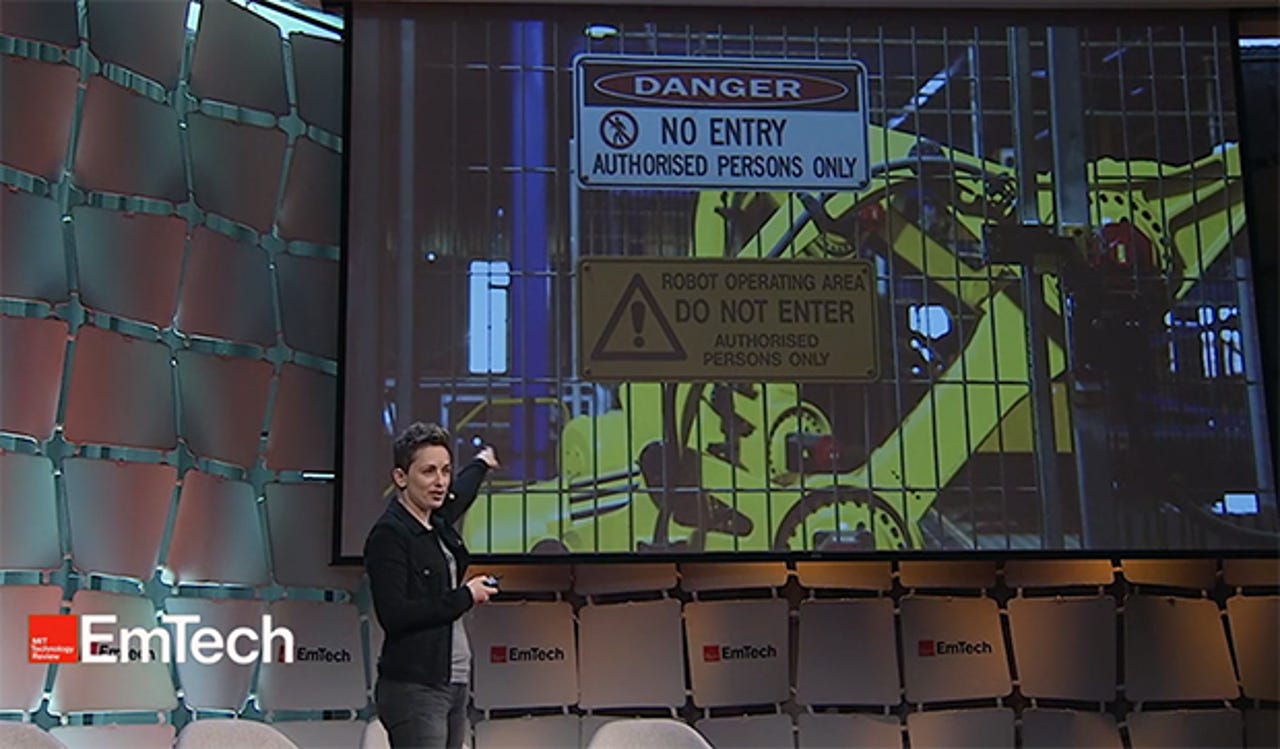EmTech MIT: Making factory robots smarter and safer


Alphas and betas may be fine for social networks. But manufacturers tend to be more conservative about technology with good reason. The industrial robots on the factory floor that hoist heavy payloads and move them around at high speeds are so dangerous that they need to be kept in separate work-cells away from human workers.
"You can't move fast and break things, if the things you might break are people," said Clara Vu, co-founder and VP of Engineering at Veo Robotics, in a talk at the EmTech MIT conference last week.
One solution to this is what's known as a cobot, a robot that is designed to work collaboratively alongside humans. Indeed, this is one of the fastest growing segments of the market. Earlier this week, at the International Manufacturing Technology Show, Universal Robots announced that it has now sold 25,000 cobots.
The catch is that cobots are safer because they are less powerful. "Cobots are small and lightweight and can't hit you very hard," Vu said. "They have transformed the industry, but they have some physical limitations--you simply can't move a big object far or fast with a cobot."
By contrast, the industrial robots used to manufacture durable goods can lift hundreds of pounds, thousands of times a day, and place them in the same spot--24 hours a day. They are far superior to humans when it comes to simple, repetitive tasks such as welding, yet completely incapable of handling more complex tasks such as final assembly, which Vu said still looks much the same way it did a century ago, noting that both GM and, more recently, Tesla tried to automate final assembly and failed.
Some of these tasks would be so expensive to automate that a manufacturer could never recoup the cost. Projects can run to the millions of dollars and involve a team of engineers working for months to customize the hardware and software. Furthermore, the result is inflexible--a slightly different part from a new supplier or one with a minor defect can shut down the entire line, which can cost an automaker about $50,000 per minute. Other tasks simply can't be automated at all with today's technology.
Even if some tasks could be automated, they often are not because entire production steps need to be either fully automated or manual for safety. "The problem is the very strength and speed and precision that makes industrial robots so powerful also makes them extremely dangerous," Vu said. "You do not want to be anywhere near a one-ton robot moving a hundred-pound object at two meters per second."
AI advances in areas such as computer vision can help with perception and reasoning, but industrial automation also requires actuation--you need to control what the robots actually do. Replicating the tasks that a human can perform on an assembly line is incredibly complex. There are 125 process steps in the final assembly of a washing machine and 500 in final assembly of a car, each with thousands of challenging sub-assembly steps.
"We are decades or even centuries away from being able to solve human actuation in the general case," Vu said. "Until we solve general AI, these techniques just aren't going to completely automate industrial production."
What we can do the in the meantime, Vu said, is make it possible for humans and robots to work more closely together, which Veo aims to do by adding perception systems to the powerful robots its customers already use. Companies like ABB, Fanuc and Kuka already supply robots with incredible mechanical systems, Vu noted, so there's no reason to build one. Instead it supplies sensors and edge compute to them so that they can operate safely alongside humans on a production line. "Essentially, what we are doing is extending the sense and perception of a cobot to much bigger systems," Vu said.
One interesting wrinkle is that, unlike many robotics start-ups, Veo does not use any machine learning. That black box approach simply won't fly with these customers. "We did not feel that we would trust our life to any of these algorithms and safety standards for industrial automation specifically prohibit some machine learning techniques," Vu said. Instead Veo relies on deterministic algorithms and the entire system is designed to be fail-safe. For example, if a robot encounters a space that is occluded--it can't see what behind it--it is programmed to assume that a human occupies that space.
Despite these precautions, it will take time to convince manufacturers that humans can work safely alongside powerful robots. Automakers are very sophisticated in terms of automation, safety conscious and used to working with big, dangerous equipment by keeping it separate from people. "People who don't know manufacturing say, 'of course the robot isn't going to hit me, it's smart'," Vu said. "You can tell how long someone has been in the industrial automation industry by how hesitant they are to walk into the workcell."
Veo has completed trials with three large manufacturers including an automaker, a major parts supplier and a consumer packaged goods company. For now, these are taking place in pre-production labs, but they give Veo a chance to understand the manufacturing environment and production processes. "To build a system to deploy in a large industrial environment that we are confident will work every time is a big challenge," Vu said. The ultimate goal is to transform human-machine interaction combining human judgment and creativity with the strength and repeatability of robots to improve productivity.
John Morris is a former executive editor at CNET Networks and senior editor at PC Magazine. He now works for a private investment firm, which may at any time invest in companies whose products are discussed in this blog, and no disclosure of securities transactions will be made. No investment advice is offered in this blog. All duties are disclaimed.